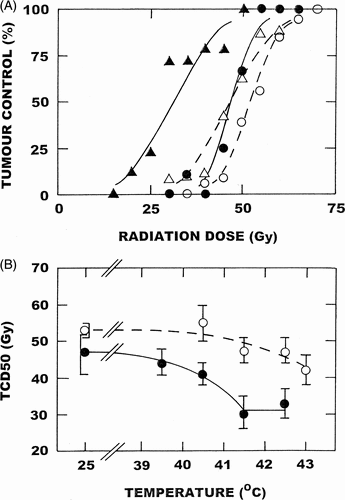Figures & data
Figure 1. Schematic illustration of how the growth of most solid tumours is dependent on the development of its own neovasculature from the normal tissue vessels by the process of angiogenesis. Also shown is how vascular targeting agents (VTAs) can be used as a therapeutic approach against the tumour vasculature. They include AIAs (angiogenesis inhibiting agents) and VDAs (vascular disrupting agents), which although similar are distinctly different in their mode of action.

Table I. Preclinical studies combining VTAs and hyperthermia.
Figure 2. Effect of DMXAA and heating on the radiation response of a C3H mammary carcinoma. (Top panel) Tumours were locally irradiated with graded radiation doses and the percentage of mice in each treatment group showing local tumour control 90 days after treatment recorded. Mice were given radiation alone (○); local heating (41.5°C; 60 minutes) starting 4-hours after irradiation (•); DMXAA (20 mg/kg) injected intraperitoneally 1-hour after irradiating (△); or treated with radiation, DMXAA and heat (▴). Points are from an average of 13 mice/group. (Bottom panel) TCD50 values (with 95% confidence intervals) determined from data similar to that shown in the top panel for heat alone (○); or DMXAA with heat (•). Data modified from references 61 and 78.
